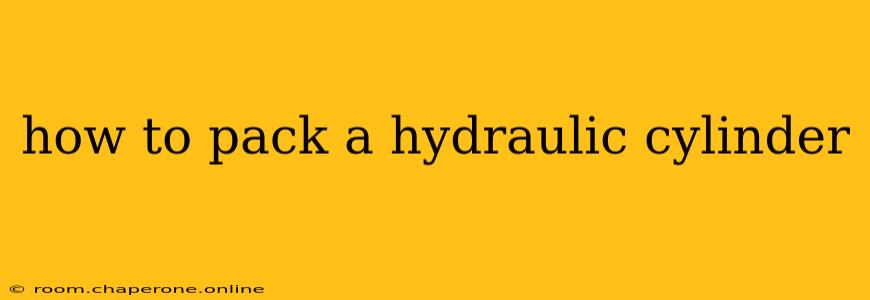Packing a hydraulic cylinder is a crucial maintenance task that ensures its efficient and reliable operation. A poorly packed cylinder leads to leaks, reduced performance, and ultimately, costly downtime. This comprehensive guide details the process, highlighting essential steps and safety precautions. This guide is for informational purposes only and should not substitute professional training or advice. Always consult your cylinder's specific manual and relevant safety regulations.
Understanding Hydraulic Cylinder Packing
Before diving into the packing procedure, let's understand the role of packing in a hydraulic cylinder. The packing, typically made of specialized materials like polyurethane or leather, creates a seal around the piston rod, preventing hydraulic fluid from leaking. Over time, this packing wears down, requiring replacement. The process involves removing the old packing and installing new material, ensuring a tight seal to maintain pressure and prevent contamination.
Essential Tools and Materials
Before you begin, gather the necessary tools and materials. This list may vary depending on your specific cylinder design, but generally includes:
- Appropriate replacement packing: Always use the manufacturer-recommended packing material. Using incorrect packing can lead to leaks and damage the cylinder.
- Socket set: For removing and installing nuts and bolts.
- Wrench set: For tightening and loosening cylinder components.
- Hammer: For carefully tapping components into place (use a soft-faced hammer to prevent damage).
- Packing installation tool: This specialized tool aids in properly seating the packing rings. (Some cylinders may require specialized tools for disassembly and assembly. Consult your manual.)
- Hydraulic fluid: The correct type and grade specified for your cylinder.
- Clean rags: For cleaning components and wiping away excess fluid.
- Gloves: To protect your hands from hydraulic fluid and sharp edges.
- Safety glasses: To protect your eyes from debris and splashing fluid.
- Cylinder disassembly instructions: (Consult your cylinder's manual)
Step-by-Step Packing Procedure
Note: The following steps provide a general overview. Always consult the manufacturer's instructions for your specific hydraulic cylinder model. Incorrect procedures can result in damage to the cylinder and potential injury.
1. Safety First: Before beginning any work, ensure the hydraulic system is depressurized and isolated. Lock out and tag out the power source to prevent accidental activation. Wear appropriate safety gear, including gloves and safety glasses.
2. Cylinder Disassembly: Carefully disassemble the cylinder according to the manufacturer's instructions. This usually involves removing the gland nuts, gland, and potentially other components. Take detailed notes or photos to aid in reassembly.
3. Packing Removal: Remove the old packing carefully, avoiding damage to the cylinder's internal components. Clean the cylinder bore and gland thoroughly with a clean rag.
4. Preparing the New Packing: Check the new packing rings to ensure they are the correct size and type. Lubricate the rings with clean hydraulic fluid to facilitate installation.
5. Packing Installation: Carefully install the new packing rings, ensuring proper alignment and seating. Use the packing installation tool (if required) to avoid damaging the packing.
6. Reassembly: Carefully reassemble the cylinder, following the steps in reverse order of disassembly. Tighten all nuts and bolts to the manufacturer's specified torque.
7. Leak Testing: After reassembly, carefully inspect the cylinder for leaks. If leaks persist, there may be an issue with the installation of the packing or other components. Recheck your work carefully and consult the cylinder's documentation for troubleshooting.
8. System Re-pressurization: Once you've confirmed the absence of leaks, carefully repressurize the hydraulic system, following the manufacturer's instructions. Monitor the cylinder for leaks during operation.
Troubleshooting Common Issues
- Leaks: If leaks persist after packing, check for damaged packing, improper installation, or other defects in the cylinder.
- Difficult Installation: If installing the packing rings is difficult, ensure you've lubricated them sufficiently and are using the correct tools.
- Incorrect Packing: Using the wrong type of packing can cause leaks and damage the cylinder. Always use the manufacturer-specified packing.
Conclusion
Packing a hydraulic cylinder is a specialized task that requires attention to detail and adherence to safety protocols. While this guide provides a general overview, it’s crucial to consult the manufacturer's instructions for your specific cylinder model. Improper packing can lead to costly repairs and potential safety hazards. If you lack the experience or confidence to perform this task, it’s always best to consult with a qualified hydraulic technician.

